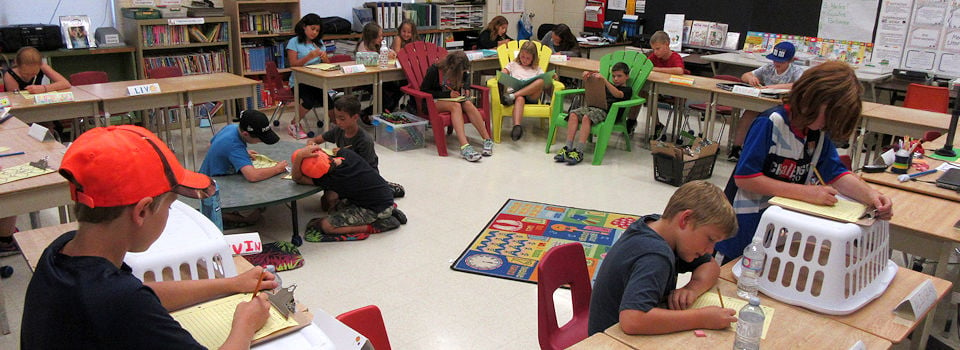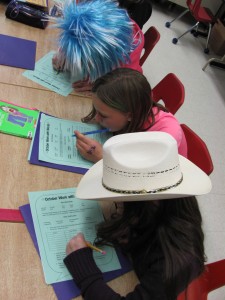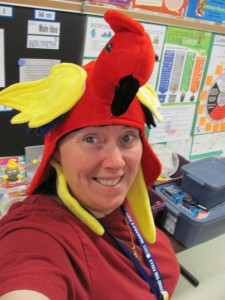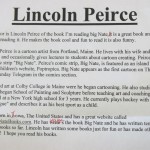The class spent the first three weeks of September reviewing literacy concepts and skills, practicing paragraph writing and completing CASI reading assessments. In Week 3, we also began Guided Reading. In the coming weeks and months, students will start working more independently on literacy skills.
Our balanced literacy program includes reading, writing, oral communication and media studies.
These are some of the elements of our reading and writing programs:
- Minds-on Literacy
- Daily Five
- Guided Reading
- Shared and Independent Reading
- Writer's Workshop
- One-on-one conferences with the teacher about goals and "next steps"

Minds-on Literacy Exercises from "Daily Language Review" and other sources,
provide grammar, punctuation, word usage and sentence editing practice.

Daily Five literacy rotations help students develop the habits of working independently, reading, reflecting on reading and expanding vocabulary. Students engage in three twenty-minute learning activity sessions within a morning literacy block, and are provided with choice regarding the order in which they complete various tasks. This year, we changed "work on writing" to "respond to text." We devote two literacy blocks per week to Daily Five.
———————————————
These are the cornerstones of our 2012-13 Daily Five program:
Read to Self: The best way for a student to become a better reader is to practice each day, with books the student chooses at his/her
just-right reading level. Students log their independent home and school reading.
Read to Someone: Reading to someone provides more time to practice strategies, helping students work on fluency and expression, check for understanding, hear their own voice, and share in the learning community.
Spelling – Word Work: Correct spelling allows for more fluent writing, thus speeding up the ability to write and get thinking down on paper. This is an essential foundation for writers. This year, students are breaking down the "nifty thrifty fifty" compound words into prefixes, root words and suffixes and working with commonly misspelled words.
Respond to Text: Reading is thinking. Responding to text means understanding the text form and the author’s intended purpose and audience, interpreting the text based on one’s own knowledge and point of view, making text-to-self, text-to-text and text-to-world connections and comprehending bias in relation to the text. Students are provided with reading response choices to use with their independent reading and reading that is assigned by the teacher.
Listen to Reading: When students hear examples of good literature and fluent reading, they learn more words, thus expanding their vocabulary and becoming better readers. In our classroom, ”listen to reading” involves the teacher or a student reading a section of a chapter book aloud to the class. This fall, we are reading "The Hobbit" aloud, in class.

For Daily Five, each student has a twin-pocket folder containing his/her
word work, in-class reading logs, reading response workbook
and various other organizational aids and tip sheets.
———————————————

Each student in our class receives regular Guided Reading instruction, in a small group setting. Our Guided Reading resource is the Nelson Literacy Kit, which includes reading folders that connect to Science, Social Studies, Health and Character Education. Pictured above are samples of Grade 5 (top) and Grade 6 (bottom) Guided Reading folders. Guided Reading usually occurs during Daily Five.
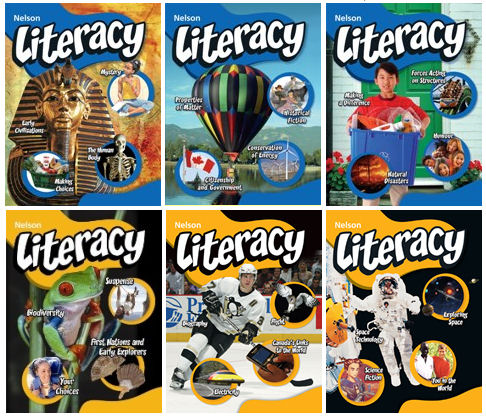
We also utilize Nelson Literacy student books, which contain Shared and Independent Reading selections and reading reflection prompts. We use these books to enrich our studies of various subjects. The Grade 5 books are shown on the top row and the Grade 6 books on the bottom.

Writer’s Workshop includes the study and practice of various forms of writing. These include: narratives, recounts, procedures, discussions, explanations, reports, and persuasive letters. Proofreading and editing of a student’s own work, providing feedback on classmates’ writing and goal setting toward becoming better writers are focal points within our writing program. Students in our class are creating writing portfolios in binders provided by the school board for this purpose. We devote two literacy blocks per week to "Writer's Workshop."

Students participate in regular One-On-One Conferences with the teacher about their goals and "next steps" in relation to reading and writing. This ensures that each student receives customized instruction and is held accountable for working toward his/her goals for improvement. These student-teacher conferences are usually held during Writer's Workshop.
———————————————
Oral and Media Literacy comprise the the other two strands in our balanced literacy program. In future BLOG posts, student-reporters will provide updates about our learning in these, and other, subject areas.
Thank you for visiting the class, via our BLOG. If you have any questions or comments, feel free to e-mail me: mblack@mail1.scdsb.on.ca or to add a comment to this page.
 Students were arranged in groups of three. Each group chose a "hard news" story from one of the newspapers, and analyzed it using the criteria on the left (click on the image to enlarge it). A "hard news" story is one that is tied to an event and/or has a sense of urgency attached to it.
Students were arranged in groups of three. Each group chose a "hard news" story from one of the newspapers, and analyzed it using the criteria on the left (click on the image to enlarge it). A "hard news" story is one that is tied to an event and/or has a sense of urgency attached to it.